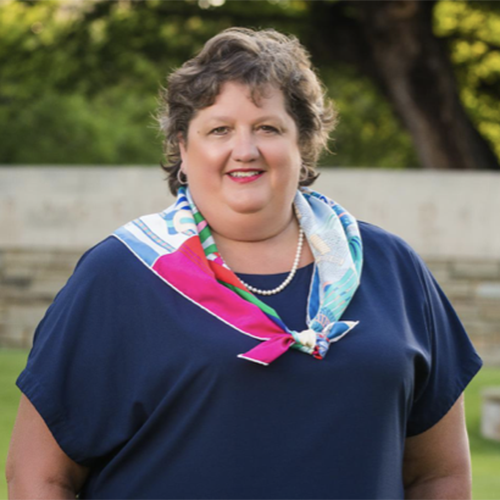By Acacia McDonald, Gaylord College Class of 2024
It’s Wednesday, April 19, 1995, 9:01 a.m. It’s a brisk, clear spring morning in Oklahoma City, and most people have just gotten to work. By 9:03, 168 people will have lost their lives, and Oklahoma City will have been changed forever. In the aftermath of the bombing outside of the Alfred P. Murrah Federal Building, storytelling will have embarked on a new frontier that will change the way it is consumed, and those changes can still be seen today.
This event would go down in history as a turning point for the way Americans receive information about events of national crisis. In a time when televisions signed off the day, and news was available in a morning and evening edition, this was being reported live, from the scene, with minute-to-minute updates on the ground.
Kari Watkins, who has served as president and CEO of the Oklahoma City National Memorial and Museum since before it opened the doors, is a graduate of the H.H. Herbert School of Journalism, now known as OU’s Gaylord College.
“It really was that event that people at home watched the bombing unfold for the first time around the clock,” Watkins said, “and journalists were key in the storytelling. They were critical.”
In addition to well-known journalists, students at OU were also revolutionizing journalism on technology known at the time as the World Wide Web. While many people are more than familiar with such technology today, in 1995, this was not a commonality for most people. “At OU students broke the story on the web to the world,” Watkins said. “It was a remarkable story in 1995. Today, you’d expect that.”
Journalists on the scene were able to go into the building during the recovery efforts, according to Watkins. “They became as important as the survivors, the first responders, the family members. The journalists were a key part of the story because they were telling the story firsthand.”
Today, these stories still matter and greatly impact people. “How do we keep this from happening? That’s why this is important today. It’s still happening,” Watkins said. “It might not be a truck bomb, it may be with guns, it may be with bullying on the internet, it may be a thousand different ways”. Ultimately, Watkins attributes the issues seen today to the widespread hatred that could be seen on many fronts in America in 1995.
“29 years ago, the world was different,” Watkins said. “When that bomb happened it wasn’t war, but we felt like we were under attack as Americans. I think people rallied, they drove to the site, and handed boots over the fence to firefighters, brought food, or did whatever they could.”
This really shows the spirit Oklahomans have, Watkins said, and is shown through the phrase coined by journalists when discussing the bombing coverage, referring to it as the “Oklahoma Standard.”
“He said he had never seen anything like this, and in all the destruction, in all the horror, people found a way to serve and be good,” Watkins said. The three pillars of that phrase are service, honor and kindness, all things that Watkins says have always been part of the spirit of Oklahomans but were noticed when the world stopped to look at the city after the bombing.
As the memorial stands today, there are two gates on either end. On the east end, the first five-story gate reads, “9:01,” the moment Watkins describes as “the innocence, the naivete that this could ever happen in our state.” On the west end is a mirrored gate with “9:03” carved into it. This one represents the moment healing and moving forward began.
“Those two gates frame the moment of 9:02 that everyone talked about. That's where the horror happened,” Watkins said.
Living today in a world that continues to heal, learn and move forward, it is people like Watkins who help tell the stories of the victims and survivors that will hopefully keep terrorist events like these from happening again. In the aftermath, Watkins says, “It was one Oklahoma, and that’s the spirit that we want people to know that we have. It shouldn’t take a crisis to get there.”
In the world post 9:03 a.m., Watkins said “the storytelling became about the people, the place and the power of unity. The word unity is in community for a reason,” and this is why the story and the storytelling surrounding it are so important today.

Gaylord Assistant Professor Nate S. Fisher, Ph.D. was recently elected vice president of the Southwest Education Council for Journalism and Mass Communication (SWECJMC) for ’25-‘26 at the organization’s annual symposium, held on the campus of the University of New Mexico in Albuquerque in November.
After a 15-year career in journalism in Bangladesh, where he rose from cub reporter to news manager overseeing a team of more than 75 journalists, Mohammad Al Masum Molla came to the University of Oklahoma seeking answers to the deeper questions his newsroom experience could not resolve.
A new exhibit in the University of Oklahoma’s Bizzell Memorial Library invites visitors to step into more than a century of storytelling and innovation in media. “An Age of Dreamers & Storytellers: Media, Mass Communication and the University of Oklahoma” celebrates Gaylord College’s 25th anniversary while tracing the evolution of journalism, advertising and media across campus and beyond.
Dr. Elizabeth Cox, a recent graduate of the Gaylord College doctoral program, has joined the faculty of the William Allen White School of Journalism and Mass Communications at the University of Kansas. She serves as an assistant professor, teaching in the Sports Media and Society and Digital Marketing Communications, Advertising and Public Relations concentrations.
Rachel Patterson, New York Times bestselling author and adjunct professor at Gaylord College, was recently featured in Cosmopolitan for the exclusive cover reveal of her upcoming novel, “The Alchemary.”